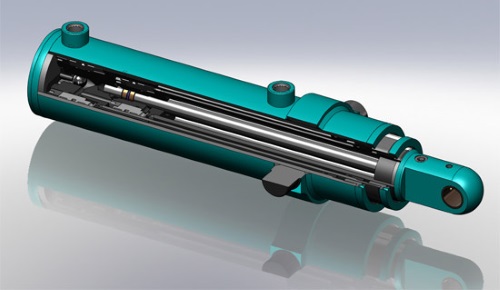
Hydraulic cylinders are specified by the force required to be pushed and moved, and they are specified by their method of mounting. There are subordinate functions to be considered when specifying a hydraulic cylinder, such fluid type, column strength and material construction. However, 90% of cylinder applications are not exotic, and simply identifying force and mounting requirements will suffice, leaving all else standard.
The first step in specifying a hydraulic cylinder is calculate the required force. Factors required to determine force are the mass of the load, direction of cylinder travel and angle of the force vector. The mass is easiest to know, in most cases. The direction of cylinder travel is also easy to determine; will the cylinder push or pull on the load? It is important to consider the difference because a cylinder pulls with less force than it pushes, due to the area taken up on the piston by the rod. The angle the cylinder pushes on the load at affects the force required, but because this part of the discussion requires trigonometry, I’ll leave it out for now. Let’s just say that if you’re not pushing at ninety degrees to the load, it requires more force.
Once the force requirement is defined, you will have to calculate the require bore of cylinder. The bore is inside diameter of the barrel, but also describes the outside diameter of the piston. The hydraulic fluid acts upon the piston, imparting force energy against it, and the larger the area of the piston or the higher the pressure you exert, the more force is generated. Are and force are calculated as such:
A = πr²
A = Area in square inches
π ≈ 3.14
r = Piston radius (1/2 diameter)
After piston area is calculated, simply multiply its area by the available system pressure:
F = P x A
F = Force in pounds
P = Pressure in psi
A = Area in square inches
Let’s take an example to help with the math. We have a 4-in. bore cylinder, and our system pressure is capable of 3000 psi:
A = 3.14 x r²
A = 3.14 x 2²
A = 3.14 x 4
A = 12.56 in²
F = P x A
F = 3000 psi x 12.56 in²
F = 37,680 pounds


Usually I don’t start with calculating the required force when specifying a hydraulic cylinder. That is probably the reason it always takes me so long to get the service done. This has been really helpful because now I know a better place to start. How do you determine the factors required to calculate force?